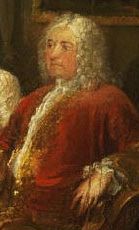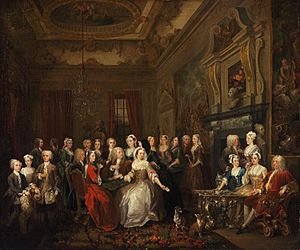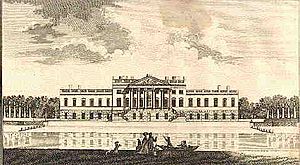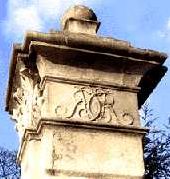Richard Child, 1st Earl Tylney facts for kids
Richard Child, 1st Earl Tylney (born February 5, 1680 – died March 1750), was an English politician. He served in the British Parliament, known as the House of Commons, from 1708 to 1734. He started his political career as a Tory but later supported the Whigs after 1715.


Richard Child is mostly remembered for building Wanstead House. This grand Palladian-style mansion was one of the first of its kind in Britain. Sadly, it was torn down a long time ago. He also supported the Flemish painter Joseph Francis Nollekens, often called "Old Nollekens." Richard Child passed away in March 1750 at the age of 70 in France. He was buried in Wanstead on May 29, 1750.
Contents
Richard Child's Family Background
Richard Child was born on February 5, 1680, and was baptized at Wanstead Church. He was the third son of Sir Josiah Child (1630–1699). His father was a very rich man and served as the Governor of the East India Company. Sir Josiah Child was made the 1st Baronet of Wanstead in 1678. Richard's mother was Emma Barnard (died 1725). She was the daughter of Sir Henry Barnard, a merchant from London.
Richard's father passed away before Richard became an adult. In his will, Sir Josiah Child named Richard as the main person to receive his remaining wealth. On February 12, 1700, Richard asked Parliament for a special law. This law would help make sure that agreements made for his half-brother Josiah's marriage were kept.
In 1703, Richard married Dorothy Glynne. She was the daughter of John Glynne. John was the son of Sir John Glynne (died 1666), who was a important judge. Dorothy's mother was Dorothy Tylney, from Tylney Hall in Hampshire. On January 20, 1704, Richard became the 3rd Baronet. This happened after his half-brother, Sir Josiah Child, 2nd Baronet, passed away. Richard also inherited the Child family's estate in Wanstead, Essex. This estate was about 6 miles northeast of London. He also received a large fortune, which brought his total yearly income to £10,000.
Building the Grand Wanstead House

After the first Baronet died, his heir Josiah leased Wanstead to his half-brother Richard. Once Richard fully owned the estate, he decided to build a magnificent new home. In 1715, Sir Richard Child, who was now the 3rd Baronet, hired the Scottish architect Colen Campbell. Campbell was tasked with designing a huge Palladian mansion. This new house would replace the older manor house.
By the time Wanstead House was finished in 1722, Richard Child had gained a new important title. He had become Viscount Castlemaine in 1718. The grand size of Wanstead House perfectly suited his new high status.
Richard Child's Political Career
Sir Richard Child first tried to become a Member of Parliament (MP) for Essex in the 1705 election. He ran as a Tory candidate but did not win. He had the support of Henry Compton, who was the Bishop of London. In the 1708 election, he was elected without anyone running against him. He became the Tory Member of Parliament for Maldon, Essex. During this time, he voted against the impeachment of Dr Henry Sacheverell.
In the 1710 election, Child was elected as a Tory MP for Essex again. He received a very high number of votes, showing how popular he was. He was part of a group called the October Club. In 1711, he was named among the "Worthy Patriots" who pointed out problems with the previous government. He also voted for a bill about French trade in 1713. In the 1713 election, he was re-elected for Essex without opposition.
Despite some challenges, Child was elected MP for Essex again in the 1715 election. Although he was elected as a Tory, he started to support the Whig government. For example, he voted for the Septennial Bill in 1716. His main goal was to become a peer, which meant getting a noble title. He bought an Irish peerage in 1715. However, he had to wait until 1718 to be made Baron Newtown and Viscount Castlemaine. Since these were Irish titles, he could still serve in the House of Commons. He voted to cancel certain laws and against the Peerage Bill in 1719. He lost the election for Essex in 1722 but was re-elected without opposition in 1727. He consistently voted with the government. On June 13, 1733, a special law allowed him to change his last name to Tylney. In the 1734 election, he stepped down from Parliament. His son John Tylney tried to get elected in his place but was not successful.
Becoming a Peer: Viscount Castlemaine
In June 1711, there was a rumor that Richard Child was going to buy a noble title for £10,000. This made some people upset, as they thought it was wrong to buy such a high status. The rumor came up again in 1711 and 1713. It turned out to be true when, on April 24, 1718, he was given two titles in the Peerage of Ireland. He became Baron Newtown in County Donegal and Viscount Castlemaine in County Kerry.
It is not known if he ever attended the Irish House of Lords. These titles were mainly meant to give him higher social standing. The title of Castlemaine had been given before in 1661 to Roger Palmer. His wife was Barbara Villiers, who was a mistress of King Charles II. The King wanted to give her status. The title was meant to pass down through her children, not his. Palmer himself never attended the Irish Parliament and died in 1705.
Inheriting the Tylney Estates
In 1730, Richard Child's wife, Dorothy Glynne, inherited the Tylney estates in Hampshire. She received them from her cousin, Ann Tylney (died 1729/30). Ann Tylney was Lady Craven, the wife of William Craven, 3rd Baron Craven (died 1739). Ann was the only daughter and heir of Frederick Tylney (died 1725). Frederick Tylney had built Tylney Hall in 1700.
Lady Craven's own daughter had passed away in 1725. Even though Lord and Lady Craven had a special law passed for their descendants to use both their last names (Craven and Tylney), they did not have any children who survived. Ann Tylney, Lady Craven, was buried in Binley, Coventry.
The Tylney Family of Hampshire
In 1629, Richard Tylney bought the manor of Rotherwick. He was already a landowner in the area. His descendant, Frederick Tylney, built a large mansion called Tylney Hall on the estate in 1700. Frederick Tylney was an MP for Whitchurch in January 1708. Tylney Hall was rebuilt in 1898 in the Victorian style and is now a country hotel. There is a marble monument in Rotherwick church dedicated to Frederick Tylney (died 1725). It was put there by his widow, Anne. The monument shows their family symbols.
Becoming Earl Tylney
On June 11, 1731, Viscount Castlemaine was given an even higher title. He became Earl Tylney, of Castlemaine in County Kerry. This was another title in the Peerage of Ireland. On June 13, 1733, the Earl changed his last name to Tylney. He did this by a special Act of Parliament. This change was required because of his wife's inheritance. His oldest son, Richard, was known as Viscount Castlemaine after his father became an Earl in 1731. However, Richard died in 1734 without children, before his father passed away.
Supporting the Artist Old Nollekens

Richard Child was the main supporter of the Flemish painter Joseph Francis Nollekens. He was called Old Nollekens to tell him apart from his more famous son, Joseph Nollekens, who was a sculptor. Many of Old Nollekens' paintings were sold at a big auction at Wanstead House in 1822, just before the house was torn down. Here are some of the paintings that were sold:
- Lot 10: "A pair—the Juvenile Artists and Companion, a Boy spinning his Top," sold for £25.
- Lot 16: "A pair—the Juvenile Parties; Card-builders and Players at Tetotum," sold for £17.
- Lot 138: "Dancing Figures, a sketch, in a French carved frame," sold for £1 2s.
- Lot 225: "Rural Recreations, painted with all the taste and elegance of Watteau," sold for £6 6s.
- Lot 307: "A Boy beating a Drum, and a small Landscape, and two curious models of the Stag and Fox in wax," sold for £8, 15s.
- Lot 308: "The Wine-Traders, painted with the tasteful elegance of Watteau," sold for £31 10s.
- Lot 3ll: "Females Bathing, in a Landscape, with a distant view of Wanstead-house," sold for £8 18s 6d.
- Lot 314: "Landscape, Buildings," &c. sold for £7.
- Lot 316: "Landscape and Figures, with a youth playing the guitar."
Other paintings by Nollekens that are connected to Wanstead House include:
- Music Party at Wanstead House
- Lord and Lady Tylney at Wanstead House (now at Longleat House)
- Music Party before the Lake at Wanstead (sold in 1965)
Richard Child's Children and Successors

Earl Tylney and his wife Dorothy Glynne had seven children:
- Emma (1707-1758): She was a twin. She married Sir Robert Long, 6th Baronet (died 1767).
- Elizabeth (1707-1710): She was Emma's twin but passed away young.
- Frederick (1709-1715): He also passed away young.
- Richard (1711-1734): He died before his father and had no children.
- John (1712-1784): He became the 2nd Earl Tylney after his father.
- Dorothy (1717-1786): She never married.
- Josiah (1718-1760): He was a Lieutenant or Captain in the Royal Navy. He is likely the officer in the blue coat in Nollekens' painting. He seems to have kept the surname "Child" and did not change it to "Tylney." He married Mrs. Henrietta Wymondsold (1729–1763). They had a son named Josiah, who was born just before their marriage. This younger Josiah was raised by his uncle but died in Florence in 1774 at age 20. Both Josiah and Henrietta had their portraits painted by Francis Cotes. These paintings are now at Lydiard Park, Swindon.
When the Earl passed away in March 1750, his oldest surviving son, John, inherited his title. John had also changed his last name to Tylney after his older brother Richard died in 1734. So, John became the 2nd Earl Tylney. The 2nd Earl was also a Member of Parliament for Malmesbury, Wiltshire, from 1761 to 1768. He was also a Fellow of the Royal Society (1746), which means he was a respected scientist. When he died in 1784 without marrying, all the family titles ended. His heir was Sir James Long, 7th Baronet. James was the son of John's oldest sister, Emma, and her husband Sir Robert Long, 6th Baronet (died 1767). Sir James Long had to change his name to Tylney-Long to inherit the estate, and he became Sir James Tylney-Long, 7th Baronet.


